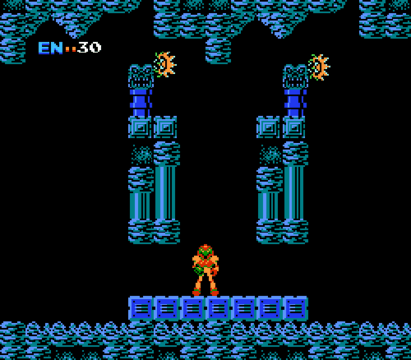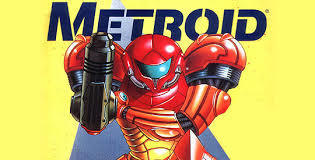In my first Rewind Review, I made it clear that I will not spare any game the luxury of nostalgia. Today, in the wake of Metroid Prime: Federation Force’s announcement at E3, I begin a daily series of Rewind Reviews that will cover the entire Metroid Series from the canonical titles, to the Prime trilogy, and even the spinoff Pinball title. Before we get to the more recent games, however, we are starting from the beginning: Metroid for the Nintendo Entertainment System.
The Plot
While the game itself carries no plot whatsoever, the game’s story is told through Metroid’s instruction booklet. The video below shows scans of the original Metroid instruction booklet released in North America, accompanied by the soothing sounds of the game’s opening music.
For those who do not enjoy reading, the summary is as follows:
In the year 2000 C.C., a number of planets established a congress known as the Galactic Federation. This allowed for prosperity among the involved planets, and civilization prospered until the Space Pirates attacked. The Galactic Federation Police were unable to defeat the pirates, and so warriors known as “Space Hunters” were sent out with the promise of bounties to stop them.
In 20X5 C.C., the Space Pirates attacked a “deep-space research spaceship” that contained a newly discovered life form – the metroid. Fearing that the metroids will be used against them, the Federation Police has sent space hunter Samus Aran to stop them. Samus – being the “greatest of all the space hunters” has “successfully completed numerous missions that everybody thought were absolutely impossible.” With his super cyborg powers, Samus will enter the caverns of Zebes and destroy the evil Giant Mechanical Organism – the Mother Brain.
Looking back at the story, Metroid was poorly written – or at least translated – back in 1986. The story sounds like something a fifth grader would have written as a short story assignment for school. That being said, the writing is very thorough and does give us some insight on what we are doing: our name is Samus Aran, and our goal is to destroy Mother Brain. Simple enough, and while it is not a compelling and gripping story, it does immerse us in an otherwise dark and pixellated universe.
Gameplay
The Good:
The good is hard to find in this game after returning from the year 2015. One of the best features of Metroid is the ability to attain new upgrades throughout the game. These upgrades grant you the ability to reach new areas, much like its predecessor The Legend of Zelda. Mixed in with tight and responsive controls, Metroid functions extremely well as a platformer.
The enemies you meet in the game are also a plus since there is a great variety in what you can expect to face as you delve deeper into Norfair or Brinstar. Bosses such as Kraid or Ridley also test players by providing an alternative to the regular jump-and-shoot style gameplay expected from similar platforming shooters like Megaman. With sequence breaking any boss can be challenged at any time, and so the methods of defeating bosses change with your chosen course. Ridley can be defeated easily by freezing his fireballs with the ice beam or you can completely avoid his attacks by using the wave beam and shooting him from the left-hand side of the stage.
While these features make for a promising game, I cannot for the life of me find anything else that is good about the game gameplay-wise. That being said, I did not begin writing Rewind Reviews for the sake of proving my childhood was better than someone else’s. As such, let us now look into…
The Ugly:
For those who have read my previous Rewind Review, you would expect to find a “bad” section. Unfortunately, this game does not warrant such a section. The game simply has not aged well.
The game lacks the most important feature of an exploration game: a map. While this is clearly a limitation of the times, it is inexcusable by today’s standards. The game flat-out does not give you any sense of direction. While third-party guides can tell you where to go, a game should not require them to be beatable. Players who have not traversed the caverns of Zebes before will find themselves lost during at least 99.9% of their gameplay. Add on the fact that there is no way of finding out what panels are accessible by using bombs, missiles, or beams and players will find themselves tossing their controller into the screen like a FIFA ’15 player who can’t score a single goal.
The difficulty of the game – similarly – comes from the limitations of the console. Beating the game is a feat many players will likely not achieve without outside interference. However, the game itself is “broken” on many levels. Dying in the early stages of the game is near unavoidable even in the first rooms since you only start with 30 health, and you have no ability to shoot enemies that are crawling along the ground.
While this is not a major issue for an eight-year-old who simply enjoys shooting at the various creatures, it is not so enjoyable for players who wish to defeat the game without having to learn every single enemy’s spawning position and movement pattern. Should a modern game be released with similar shortcomings it would be branded as a gameplay issue unless it was the intent of the game’s genre, and so by Rewind Review standards, the score of this entry in the Metroid series suffers as a result.
Another major issue is the reliance on the instruction booklet. Without it, players will be at a loss for what each item they acquire does. There is absolutely nothing in-game that explains what the weird dragon-looking thing or blue ball you picked up actually does. While this is excusable in The Legend of Zelda since we should know what a bow and arrow does, and we hopefully know what a boomerang or a bomb does, Samus’s arsenal is not so straightforward. While beam upgrades are self-explanatory once you fire at something, upgrades such as bombs or missiles leave players wondering what they are actually used for (or sometimes how to use them at all).
Presentation

Nine-in-ten odds are that the image above sends a familiar tune through the minds of Metroid Series veterans. Presentation is where the game truly shines, for even in its humble beginnings Metroid (NES) aims to please. The music is by far the most immersive in the NES library, giving players a wide variety of background music from the feeling of isolation during the title screen to the uneasiness of Kraid’s theme.
The graphics on the other hand are severely dated. While I was much harsher on gameplay, it is difficult to justify complaints about the Nintendo Entertainment System’s inability to output anything more than what Metroid has to offer. However, Metroid does have an issue with consistency in terms of sprite artwork. The issue comes clearest when comparing the game’s protagonist with the boss Kraid.
Anyone who has not played Metroid on the NES could easily assume that the above image was made in Adobe Photoshop, and not an actual image from the game. While this is not a flaw by any means, it certainly does take away from the graphics component of the game as this is not the only case in which Metroid fails to offer well designed sprites. The worst of the sprites is Ridley (as seen in the gameplay section) who looks like an unborn fetus, and not the dragon-ish creature that was intended.
The Verdict
While Metroid may have been a ground-breaking back in its day, the game just does not call for re-visitation in 2015. The game lacks many components that make a game of its genre entertaining or functional. That does not mean, however, that the game should not be played. It is a great game when used to reflect upon how far Metroid has come as a series, and it is still very much a playable game. Just be sure to keep your computer or smartphone nearby just in case you get stuck.
This ends Day 1 of my Metroid Rewind Review series. Be sure to check back on this article, or GameSkinny for future reviews as we make our way from the original 1986 Metroid on the NES to the 2010 release of Metroid: Other M.
Reviews in this Series:
- Metroid (NES)
- Metroid II: Return of Samus (GB)
- Super Metroid (SNES)
- Metroid Fusion (GBA)
- Metroid Prime (GC/Wii/Wii U)
- Metroid: Zero Mission (GBA)
- Metroid Prime 2: Echoes (GC/Wii/Wii U)
- Metroid Prime Pinball (NDS)
- Metroid Prime Hunters (NDS)
- Metroid Prime 3: Corruption (Wii/Wii U)
- Metroid: Other M







Published: Jul 7, 2015 07:38 am